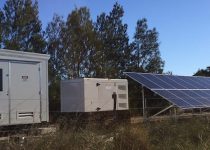University of Adelaide starts work on solar and mixed storage microgrid

The $7 million project will combine both vanadium flow and lithium-ion battery storage technology, alongside the solar, in a combination similar to that being used at the heart of the microgrid at Victoria’s Monash University.
The University of Adelaide announced earlier this month the commencement of works on the solar farm, which is expected to generate enough to supply around 40 per cent of the campus’ electricity needs.
Construction are being led by TEC-C Investments, who will also install the batteries, design the microgrid, and complete the necessary electrical upgrades.
The solar and storage project was one of 20 to receive funding through the South Australia government’s $150 million Renewable Technology Fund – in this case, a $778,500 grant towards the hybrid battery storage solution.
State minister for energy, Dan van Holst Pellekaan said the project demonstrated the University’s commitment to improving renewable energy technology.
The $1.5 million hybrid battery storage system is expected to had added value as a part of the broader South Australian electricity grid, and as an on-campus teaching tool on remote-energy management, energy storage and demand management.
“The solar farm will be a ‘living laboratory’ for students and researchers, with access to time-lapse recording of the construction, building plans and data systems for remote-energy management, energy storage and load flex,” said the University’s chief operating officer, Bruce Lines.
“Our researchers will utilise the solar farm and battery storage systems for projects including energy management strategies, grid segregation, low-cost fault detection systems, system resilience, and cybersecurity.”
Professor Peter Rathjen, vice chancellor and president of the University of Adelaide, said energy was one of the five priorities the uni had set for itself.
Minister for Energy and Mining Dan van Holst Pellekaan said: “The Marshall Liberal Government congratulates University of Adelaide on reaching this milestone and its commitment to improving renewable energy technology.”
“Put simply, this project will reduce the University’s peak electricity demand, reduce energy costs and increase the resilience of supply to the campus.”
The $1.5 million hybrid battery storage system will demonstrate the hybrid battery’s support to the South Australian electricity grid and assist the university to incorporate topics such as remote-energy management, energy storage and demand management into its teaching.
“This is not just a solar farm,” Rathjen said at the sod-turning event. “This is a mix of infrastructure, of research, of teaching, of education at its truest.
“It hopefully will help shape the future of the south Australian energy industry and help us transition to a low carbon economy.”
Universities all around Australia have been at the leading edge of renewable energy and microgrid technology, as both centres of research and development and energy-intensive businesses.
Just this week, the University of the Sunshine Coast in Queensland completed a 2.1MW solar and “water battery” project, that uses PV generation to cool water in a massive storage tank, that is then used to power the campus’ air-con.
And on August 20, Victoria’s La Trobe University unveiled an ambitious $75 million plan to become Victoria’s first tertiary education facility to reach net zero emissions, setting a target date for 2029 – one year ahead of rival Monash University’s own 2030 goal.
La Trobe has said the 20-project plan would include the installation of more than 7,000 solar panels on 27 buildings across the University’s Bundoora campus, as well as a possible large-scale PV generator.

Sophie is editor of One Step Off The Grid and deputy editor of its sister site, Renew Economy. Sophie has been writing about clean energy for more than a decade.


